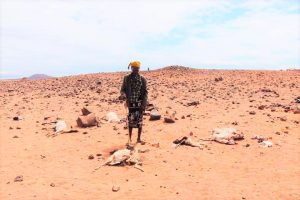[gravityform id=”1″ title=”false” description=”false” ajax=”true”]
Mashariki Television Networks Limited Email: info@themasharikinewspaper.com
Email Us
Our address
Mashariki Communications Centre
Meru-Maua Road
Main Telephone: +254 797 372 837
Postal Address: P. O. Box 747-60200, Meru, KenyaWe are social

A pastoralist stands over the carcass of his animals in Marsabit that succumbed to the effects of drought | PHOTO-Courtesy
By Correspondent
In the recent past, Kenyans from different parts of the country have experienced unending food crises brought about by multiple factors key among them unpredictable weather.
Even in areas previously referred to as food baskets like Meru, Embu, and Tharaka Nithi, the farmers are also crying, with no food for their consumption, and no food for sale.
The scenario is worse in arid and semi-arid areas of the regions like Isiolo, Kitui, and other parts of Rift Valley that include most parts of Samburu and Laikipia.
The national and county governments have been initiating plans and strategies to mitigate the issue but no plan has provided a solution.
The residents are still struggling to feed themselves and securing a plate for the following day is not guaranteed.
In the new budgets done by the governments, there isn’t evidence of tangible resources and plans to tackle the problem. The people have put their hope in natural remedies like the weather.
According to the Integrated Food Security, IPC, an NGO that works on food security surveys; the latest data shows a likely unprecedented deterioration in Kenya’s food security situation, with over 5.4 million people experiencing acute food insecurity between March and June this year and likely to deepen in the coming months.
During the last short rains harvest season, a slight decrease in the severity of food insecurity was observed across Kenya’s arid and semi-arid lands areas, which presented four counties namely Isiolo, Turkana, Marsabit, and Madera that improved due to the direct impact of the rains on livelihoods in these areas.
The provisional alleviation of food insecurity conditions in these areas in particular, however, did not translate into an improvement to the Extremely Critical level of acute malnutrition in parts of Marsabit particularly Laisamis and Turkana South, and other areas, like North Turkana, Wajir and North Horr also projected to reach Extremely Critical levels of acute malnutrition.
In the current period, it is estimated that around 4.4 million people which constitutes 27% of the ASAL population are currently facing high levels of Acute Food Insecurity.
The severity of food insecurity is expected to worsen again: about 5.4 million people who make up 32% of the population analyzed are projected to face high levels of acute food insecurity.
This latest projection represents the highest magnitude and severity of acute food insecurity in the ASAL areas in years; urgent action is required to reduce food gaps, protect their livelihoods, and prevent and treat acute malnutrition.
Laisamis in Marsabit County and Turkana South were classified in Extremely Critical levels of Acute Malnutrition.
Acute food insecurity, primarily due to low milk availability, high disease burden, and suboptimal multi-sector interventions to address the needs, compounded by insecurity, are amongst the major contributing factors in the worst affected areas.
On the other hand, the deteriorating nutrition situation is mainly attributed to the worsening food insecurity, characterized by low milk availability, increasing food prices, unfavorable terms of trade, and insufficient water.
The latest report on consumer price indices and inflation since April 2023 released by the Kenya National Bureau of Statistics overall year-on-year inflation rate as measured by the Consumer Price Index (CPI) was 7.9 percent, in April 2023.
The increase in inflation is largely due to an increase in prices of commodities under Food and Non-alcoholic Beverages (10.1%); Housing, Water, Electricity, Gas, and other fuels increased by 9.6% while transport shot by 9.8% between April 2022 and April 2023. These three divisions account for over 57 percent of the weights of the 13 broad categories.
Prices of commodities under furnishings, household equipment, and routine household maintenance recorded an increase of 6.7 percent over the period.
The prices for potatoes, beans, and mangoes increased by 7.2, 5.0, and 3.5 percent, respectively between March 2023 and April 2023.
The housing, water, electricity, gas, and other fuels index, increased by 2.7 percent between March 2023 and April 2023.
This was mainly due to an increase in prices of electricity which increased by 18.7 percent for 50 Kilowatts and 13.7 percent for 200 kilowatts between March 2023 and April 2023. The Transport Index went up by 0.2 percent between March 2023 and April 2023.
Residents of the Upper Eastern are continuing to feel the effects of a bad economy that is killing various productive areas.

Comments (0)